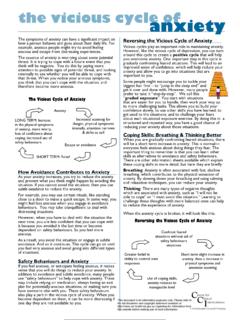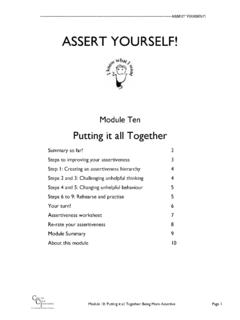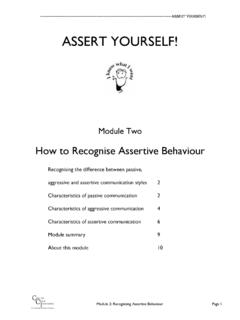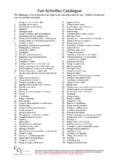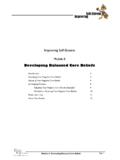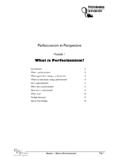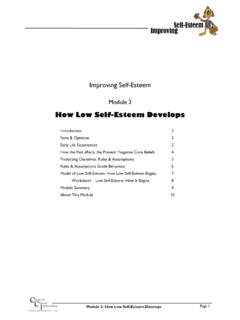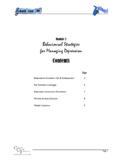Transcription of PANIC STATIONS Panic Stations - Centre for …
1 PANIC STATIONS . PANIC STATIONS . The information provided in this document is for information purposes only. Please refer to the full disclaimer and copyright statement available at regarding the information on this website before making use of such information. PANIC STATIONS Module 1. Overview of PANIC Introduction 2. Understanding PANIC and Fear 2. PANIC and Anxiety 3. Anxiety Symptoms Worksheet 7. Module Summary 8. About This Module 9. Completing Activities On Screen: To make the modules more interactive, you can type your responses on screen whenever you see instructions typed in blue. If you have Adobe Reader you CANNOT SAVE YOUR. RESPONSES. To keep a copy, please print the pages as a record. If you have the full Adobe Acrobat, you can save your responses. If you don't want to do the activities on screen, you can print out the module and work through it by hand.
2 C entre for CI linical nterventions Module 1: Overview of PANIC Page 1. Psychotherapy Research Training PANIC STATIONS . Introduction PANIC and anxiety can affect any kind of person at any stage of their life. In fact, it is estimated that about 1. in every 30 people experience significant PANIC at some time in their life. So remember, you are not alone. The aim of this InfoPax module is to provide you with some general information about PANIC attacks and PANIC disorder, and to describe the types of symptoms common to PANIC . Understanding PANIC and Fear To understand PANIC , we need to understand fear. You can think of fear as an automatic alarm response that switches on the moment there is danger. Think about what would happen to you if a dangerous animal approached you. For most people it would be PANIC STATIONS ! You, and almost everyone, would go through a whole series of bodily changes, like your heart pumping, breathing faster, sweating, all in order to respond to the danger in front of you.
3 This alarm response would probably lead us to either run for our lives or become sufficiently pumped up' to physically defend ourselves. It is, in fact, an important survival mechanism. Sometimes, however, it is possible to have this intense fear response when there is no danger in a way, it is a false alarm that seems to happen when you least expect it. This initial PANIC attack is the same brief, intense episode of fear or uneasiness that you might have in response to realistic danger, but it happens in situations that most people would not be afraid about. It is like someone ringing the fire alarm when there is no fire! Let's have a look at some of the symptoms of a PANIC attack: ) Skipping, racing or pounding heart ) Dizziness, lightheadedness, feeling faint ) Sweating ) Tingling or numbness in parts of your body ) Trembling or shaking ) Hot flushes or chills ) Shortness of breath or difficulty breathing ) Feeling things around you are strange, unreal, detached, unfamiliar, or feeling detached from ) Choking sensations your body ) Chest pain, pressure or discomfort ) Thoughts of losing control or going crazy ) Nausea, stomach problems or sudden diarrhoea ) Fear of dying Many people experience some mild sensations when they feel anxious about something, but a PANIC attack is much more intense than usual.
4 It includes 4 or more of the above symptoms, and peaks within about 10. minutes. As you can see from the list, many of the symptoms are similar to what you might experience if you were in a truly dangerous situation. A PANIC attack can be very frightening and you may feel a strong desire to escape the situation or to seek emergency assistance. PANIC disorder is used to describe the condition where PANIC attacks seem to happen unexpectedly rather than always in predictable situations. Importantly, someone with PANIC disorder has a persistent fear of having another attack or worries about the consequences of the attack. Many people change their behaviour to try to prevent PANIC attacks. Some people are affected so much that they try to avoid any place where it might be difficult to get help or to escape from. When this avoidance is severe it is called agoraphobia.
5 If your symptoms are very severe or if a doctor has not checked your symptoms, it is important to have an assessment conducted by a qualified health professional. It is important to ensure that these symptoms are the result of anxiety and not caused by something else. C entre for CI linical nterventions Module 1: Overview of PANIC Page 2. Psychotherapy Research Training PANIC STATIONS . PANIC and Anxiety When we talk about a PANIC attack, it is very much a sudden and intense episode of physical and emotional reactions. However, when we are anxious we often feel similar symptoms, such as tensing up to prepare ourselves for what might happen next. You might think of anxiety as worry or nervous apprehension about the future, a sense that you cannot control or predict future events. Feeling anxious and afraid is very much a part of the experience of being human.
6 Although you might not think so, anxiety can actually be helpful. Feeling a little anxious about something means we will be more alert and responsive to our environment, just as athletes often pump themselves up before an event. It is only when there is a very high level of anxiety that it might begin to cause us some difficulties. Fear is also part of being human. As mentioned, fear is a true alarm that signals imminent danger and allows our bodies to respond to increase our chances of survival. However, there are other times when real physical danger isn't there. Think about a person walking through a poorly lit alley at night. They might feel anxious because they are worried that something dangerous may happen. Now, there may or may not be anything dangerous in the alleyway, but what is important is that they believe there is something dangerous. It is this belief that causes the anxiety.
7 FIGHT/FLIGHT RESPONSE. When there is real danger, or when we believe there is danger, our bodies go through a series of changes called the fight/flight response. It helps us to respond to real physical threat. When a person's fight/flight response is activated, three major types of responses occur. These include physiology (body responses), behaviour (action responses), and cognitions (thinking responses). Physiology When we become anxious and afraid, be it in response to physical threat or in situations where there is no real danger, our bodies experience several changes. Some of these symptoms have already been mentioned, such as heart pounding, breathing more quickly, sweaty palms, and lightheadedness. These are common reactions that occur when we become anxious. You can type your responses below, or print this page out and write them in later. Press "tab" to move to the next line.
8 Think about some of your own physical responses when you become anxious - what do you notice? You might think you are alone in reacting this way, but really, we all experience these types of reactions when we experience fear and anxiety. Basically, our bodies are designed to release certain chemicals when we believe a threat exists, in case we need to either run away, or stand and be ready to fight. There are important reasons why these reactions occur. An increase in heart rate and strength of heart beat enables blood and oxygen to be pumped around the body faster so you might feel like your heart is pounding'. An increase in the rate and depth of breathing allows more oxygen to be taken into the body. You may start to sigh, to yawn, or notice breathlessness, choking or smothering feelings, tightness and pain in the chest. This response also reduces the blood supply to the head, and while not dangerous, you might feel dizziness, light-headedness, blurred vision, confusion, feelings of unreality and hot flushes.
9 A redistribution of blood from areas that aren't as vital to those that are, such as away from skin, fingers and toes towards large vital organs. Your skin might look pale or you might feel cold, or there might be a feeling of numbness and tingling in your fingers and toes. C entre for If you typed your responses, don't forget to print this page to keep as a record CI linical nterventions Module 1: Overview of PANIC Page 3. Psychotherapy Research Training PANIC STATIONS . An increase in sweating causes the body to become more slippery, making it harder for a predator to grab, and also cooling the body, preventing it from overheating. Widening of the pupils of the eyes lets in more light and enables you to better scan the environment for danger. You may notice blurred vision, spots before the eyes, or just a sense that the light is too bright. Decreased activity of the digestive system allows more energy to be diverted to fight/flight systems.
10 A decrease in salivation may leave you with a dry mouth and decreased activity in the digestive system may lead to feelings of nausea or a heavy stomach. Muscle tension in preparation for fight/flight results in subjective feelings of tension, sometimes resulting in aches and pains and trembling and shaking. The whole physical process is a comprehensive one that often leaves the individual feeling quite exhausted. As you can see, these physical alarm responses are important when facing danger, but they can also occur when there is a false alarm, when there is no danger. Hyperventilation and anxious breathing For some people with PANIC , breathing can play a role in PANIC attacks and PANIC disorder. You may know that when we breathe in we take in oxygen that is used by the body, and we breathe out carbon dioxide. In order for the body to run efficiently, there needs to be a balance between oxygen and carbon dioxide.
